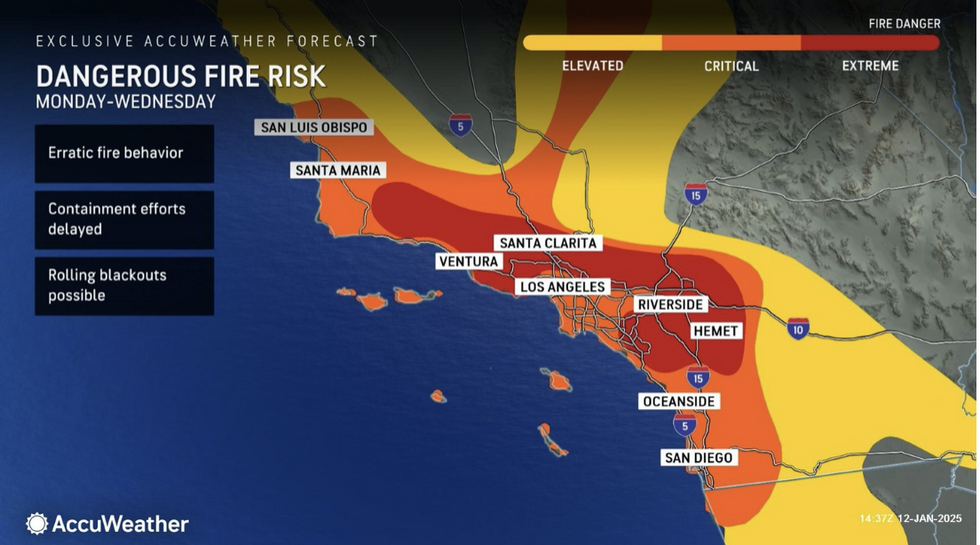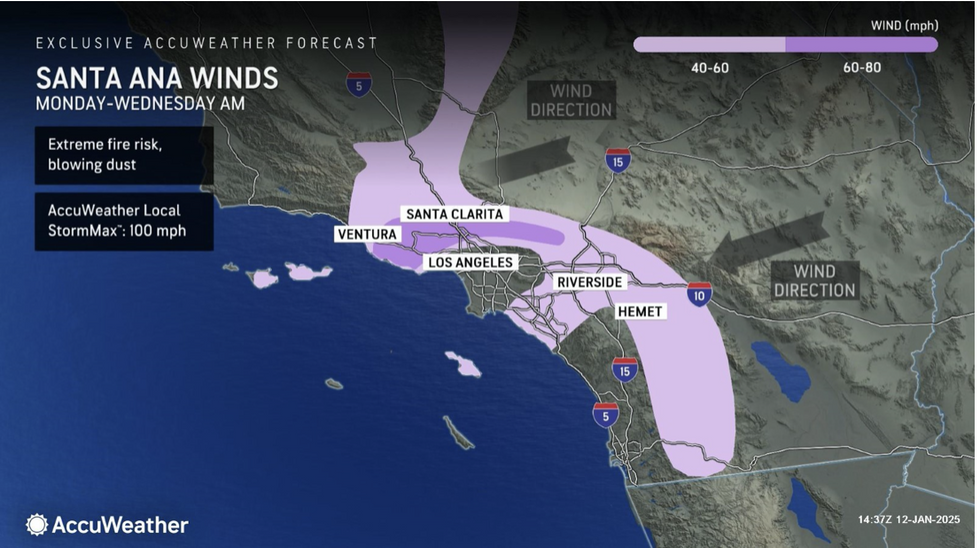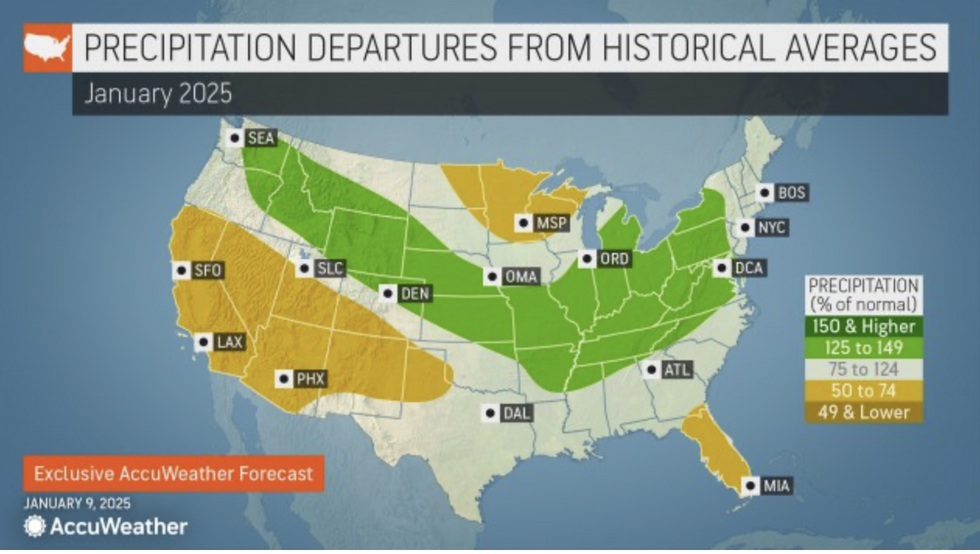Nathan Rao
Guest Reporter
Fire-fuelling Santa-Ana winds will get a boost from a huge Pacific storm as 100mph gusts push the threat level beyond ‘critical’.
National Weather authorities have in the past 24 hours issued ‘extreme critical fire’ warnings across California as the blaze shows no signs of retreat.
Unstoppable incendiary Santa-Ana winds are the main driver, hurtling from desert regions towards western states.
Now, a major storm off the Pacific coast will join forces with the so-called ‘Devil winds’, pushing gusts beyond hurricane strength.

AccuWeather meteorologist Alyssa Glenny said: “A storm developing offshore from Southern California paired with high pressure centred over the West is creating yet another setup for dry, offshore winds.
“This round of strong winds could rival the initial event in some areas that allowed fires to rapidly spread, with gusts of between 60mph and 80mph possible across the cities of Ventura and Santa Clarita.
“The maximum for this wind event is 100mph and is most likely in the higher terrain and mountains surrounding the Los Angeles basin.”
The wildfires have resulted from a lethal cocktail of weeks of dry weather, continued lack of rain, and the eruption of bone-dry Santa-Ana winds.
Also called ‘Diablo’ winds, they are driven by high pressure in desert regions forcing torrents of dry air towards low pressure further west.
LATEST DEVELOPMENTS:

The winds have not only fed the flames in regions already ablaze but forced them to spread into surrounding regions.
Authorities will now have all eyes on the weather as a growing low-pressure storm off the west coast cranks up the threat.
AccuWeather meteorologist Alex DaSilva said: “This will be another incredibly dangerous week near the fire zones and across much of the Los Angeles region as stronger wind gusts return, so please follow official evacuation orders.
“We could face another round of hurricane-force wind gusts in some places, and wind gusts could ground some firefighting aircraft, making it more difficult for crews to contain wind-driven fires.
“People need to be packed up and ready to evacuate in a matter of moments.”
AccuWeather meteorologist Paul Pastelok added: “The magnitude and timing of the most intense wind gusts will depend on the location of a storm off the Pacific Coast.”
Strong winds carry the added risk of spreading clouds of toxic smog as experts warn those in affected areas to wear respirator masks.
Poor air quality is expected to persist through the next week and even after the fires have burnt out.
AccuWeather chief meteorologist Jonathan Porter said: “The exposure to unhealthy and dangerous wildfire smoke is causing major impacts to physical and mental health for millions of people across the Los Angeles area.
“Poor and unhealthy air quality is expected in parts of the Los Angeles region through much of next week as wildfires continue to burn.”

Desperately needed to quench the flames is long-absent rainfall, although the outlook is for more dry weather.
Jim Dale, US meteorologist for British Weather Services, and co-author of ‘Surviving Extreme Weather’, said: “It is very unusual to have gone this long without rainfall, but that is the only thing that is going to stop these fires.
“The chance of any rain in the near future, though, is next to zero, with parts of the region after weeks of dry weather turning almost desert-like.”
Find Out More...
National Weather authorities have in the past 24 hours issued ‘extreme critical fire’ warnings across California as the blaze shows no signs of retreat.
Unstoppable incendiary Santa-Ana winds are the main driver, hurtling from desert regions towards western states.
Now, a major storm off the Pacific coast will join forces with the so-called ‘Devil winds’, pushing gusts beyond hurricane strength.

AccuWeather meteorologist Alyssa Glenny said: “A storm developing offshore from Southern California paired with high pressure centred over the West is creating yet another setup for dry, offshore winds.
“This round of strong winds could rival the initial event in some areas that allowed fires to rapidly spread, with gusts of between 60mph and 80mph possible across the cities of Ventura and Santa Clarita.
“The maximum for this wind event is 100mph and is most likely in the higher terrain and mountains surrounding the Los Angeles basin.”
The wildfires have resulted from a lethal cocktail of weeks of dry weather, continued lack of rain, and the eruption of bone-dry Santa-Ana winds.
Also called ‘Diablo’ winds, they are driven by high pressure in desert regions forcing torrents of dry air towards low pressure further west.
LATEST DEVELOPMENTS:
- Michelle Obama will MISS Trump's inauguration with 'no reason provided'
- Melania Trump admits she 'doesn't always agree with what her husband says and does'
- Starbucks launches crackdown on nuisance cafe users as rules tightened

The winds have not only fed the flames in regions already ablaze but forced them to spread into surrounding regions.
Authorities will now have all eyes on the weather as a growing low-pressure storm off the west coast cranks up the threat.
AccuWeather meteorologist Alex DaSilva said: “This will be another incredibly dangerous week near the fire zones and across much of the Los Angeles region as stronger wind gusts return, so please follow official evacuation orders.
“We could face another round of hurricane-force wind gusts in some places, and wind gusts could ground some firefighting aircraft, making it more difficult for crews to contain wind-driven fires.
“People need to be packed up and ready to evacuate in a matter of moments.”
AccuWeather meteorologist Paul Pastelok added: “The magnitude and timing of the most intense wind gusts will depend on the location of a storm off the Pacific Coast.”
Strong winds carry the added risk of spreading clouds of toxic smog as experts warn those in affected areas to wear respirator masks.
Poor air quality is expected to persist through the next week and even after the fires have burnt out.
AccuWeather chief meteorologist Jonathan Porter said: “The exposure to unhealthy and dangerous wildfire smoke is causing major impacts to physical and mental health for millions of people across the Los Angeles area.
“Poor and unhealthy air quality is expected in parts of the Los Angeles region through much of next week as wildfires continue to burn.”

Desperately needed to quench the flames is long-absent rainfall, although the outlook is for more dry weather.
Jim Dale, US meteorologist for British Weather Services, and co-author of ‘Surviving Extreme Weather’, said: “It is very unusual to have gone this long without rainfall, but that is the only thing that is going to stop these fires.
“The chance of any rain in the near future, though, is next to zero, with parts of the region after weeks of dry weather turning almost desert-like.”
Find Out More...
